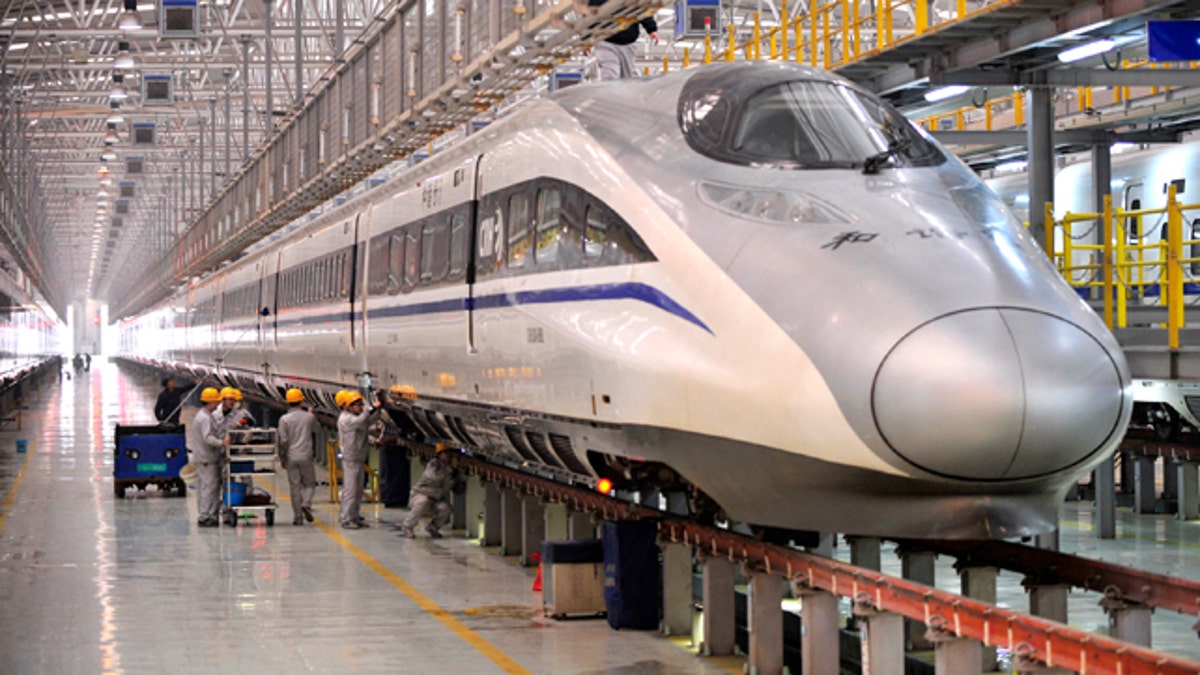
XI AN, CHINA - JANUARY 07: (CHINA OUT) Mechanics check a high-speed train at Xi'an Electric Multiple Unit Maintenance Base on January 7, 2014 in Xi An, China. The 40-day 2014 Spring Festival travel rush will start on January 16 as more than 257 million passenger trips will be made on the railways. (Photo by ChinaFotoPress/Getty Images) (2013 Getty Images)
High-speed trains traversing long distances in mere hours or seamlessly crossing international borders without even a pause are nothing new. The first “bullet” train entered service in Japan in 1964, and the Eurail system in Europe has made rapid travel between twenty-seven countries easier than ever. But crossing national borders by train in Europe doesn’t raise nearly as many security concerns as the concept of a similar high-speed train traveling between the United States and Mexico.
Last week, U.S. and Mexican officials began discussing plans for developing the first high-speed train to connect two countries in North America. This planned rail line would connect the U.S. city of San Antonio in Texas and the Mexican city of Monterrey in Nuevo León state. The roughly 300-mile route takes about five hours by car, but northbound drivers might have to tack on a considerable amount of time to go through the mandatory border inspection. Although the planning is in the initial stages and the details are murky, the idea is to have passengers go through security and immigration checks at the point of departure to allow the train to cross the U.S.-Mexico border without stopping.
Complications arise when you involve a pre-cleared high-speed train that contains hundreds of people, each one potentially working as a drug courier or mule — let alone an operational terrorist. How intrusive would Peña Nieto allow security checks to be?
The primary advantage of such a system would be the facilitation of trade between two of the most vibrant cities relatively near the border. Moving people, and ostensibly some cleared goods, between the two regions could be a real boon to the respective local economies. Family visits and tourism could also significantly increase in and near the two cities, especially given the large Mexican-American community in Texas and the busy industrial and education mecca that is Monterrey.
It should come as no surprise that Mexico is pushing for this rail connection more than the U.S. contingent. Mexico hasn’t had cross-country passenger rail service since 1997, when Ferrocarriles Nacionales de México suspended it and limited trains to just a few tourist routes. President Enrique Peña Nieto has proposed several intercity routes in his plan to revive passenger service, so any concrete steps taken towards making this cross-border route a reality would no doubt be a huge benefit for the Mexican government.
But how much is Peña Nieto willing to concede in order to allay any security concerns of the U.S. government?
Cross-border freight service has been in operation between the U.S. and Mexico for quite some time. However, the terrorist attacks of 9/11 and the surge in cartel-related violence in Mexico has led the U.S. Department of Homeland Security to dramatically increase scrutiny of trains coming into the U.S. through the handful of southwest border rail crossings. Large X-ray and gamma ray scanning machines now pore over every rail car as they cross the border, looking for telltale signs of contraband and hidden compartments.
Mexican drug traffickers are making full use of those rail cars. For example, between 2009-2011, over 20 tons of marijuana were discovered inside rail cars owned by Union Pacific despite the screening, which resulted in $388 million in fines levied against the corporation. Union Pacific disputed the judgment, saying that even though they have their own police force and inspectors, those officers cannot be armed in Mexico and cannot inspect the trains as thoroughly as they would like at their point of departure.
And these are just the problems involving stashing drugs on freight trains. Even more complications arise when you involve a pre-cleared high-speed train that contains hundreds of people, each one potentially working as a drug courier or mule — let alone an operational terrorist. How intrusive would Peña Nieto allow security checks to be, considering he would likely want to encourage extensive use of this new cross-border transit route? And how involved would he allow U.S. law enforcement or rail security to become?
Given the glacial rate with which initiatives like these tend to move forward in Latin America, project planners will likely have years to work out the details. But for a Mexican president who has slowly been pushing the U.S. away with regards to security cooperation, he may have to think twice about taking this tack if he wants to overcome U.S. security concerns over a potential high-speed drug pipeline into Texas.
